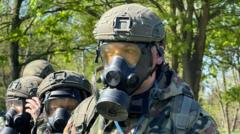In Poland, everyday citizens are stepping up their readiness as fears of a Russian invasion loom large. Near Wroclaw, people of all ages stand in line at military training sessions, eager to sharpen their survival skills. A Polish soldier leads the exercises, teaching everything from shooting accuracy to hand-to-hand combat, as participants engage in the "Train with the Army" initiative. Captain Adam Sielicki, who oversees the program, highlights the importance of being prepared: "The times are dangerous now, we need to be ready."
This military training has gained immense popularity, prompting government plans to expand the initiative to involve all adult males in Poland. The nation, sharing borders with both Russia and Ukraine, has decided to allocate nearly 5% of its GDP to defense spending, the highest among NATO members. Prime Minister Donald Tusk has echoed the sentiment, declaring Poland's aim to foster "the strongest army in the region." The push extends beyond training; Poland is strategically acquiring military assets like planes and missiles from allied nations, including the US and South Korea.
Individuals like Dariusz, attending the Wroclaw course, express a willingness to defend Poland if attacked. Many, like Agata, feel a sense of unease attributed to political shifts including the election of Donald Trump and fluctuating US military commitments. The withdrawal of US troops from a key base in Poland has only intensified these fears.
Efforts are underway for Poland to create new military partnerships—defense agreements with France and the UK are on the horizon. Amidst this backdrop, legends of historical invasions, like that of 1939 remembered by 98-year-old Wanda Traczyk-Stawska, reinforce the necessity of vigilance against potential aggressors.
While interest in military training surges, there is still hesitance among the younger generation—polls show a reluctance to enroll as volunteers in case of war. As citizens construct bomb shelters and prepare for possible conflict, uncertainty lingers. Some students express a preference for fleeing over fighting, revealing a divide in willingness to defend the homeland. As the geopolitical landscape continues to shift, one thing remains clear: Poland is arming itself with both weapons and resolve.

















